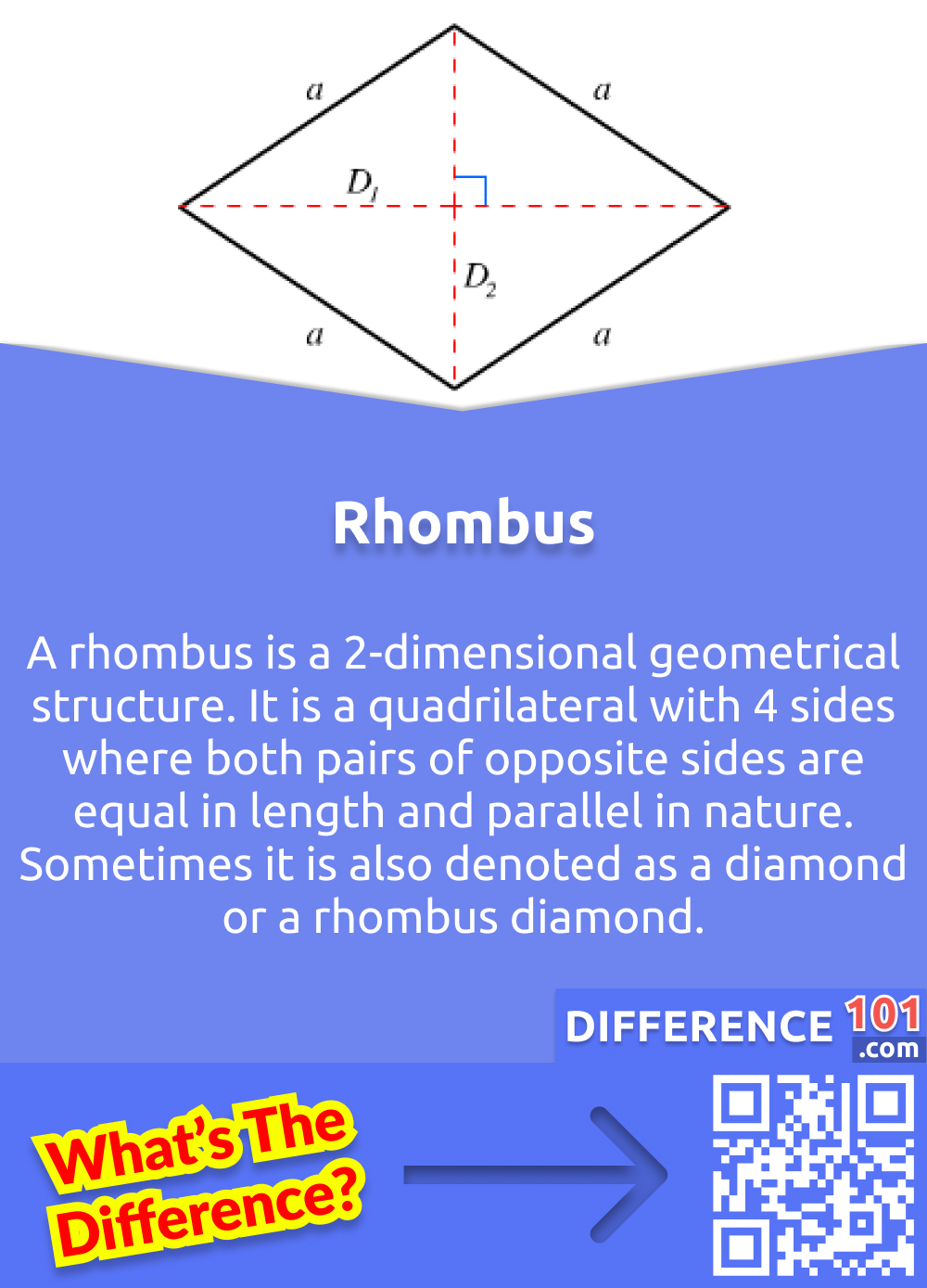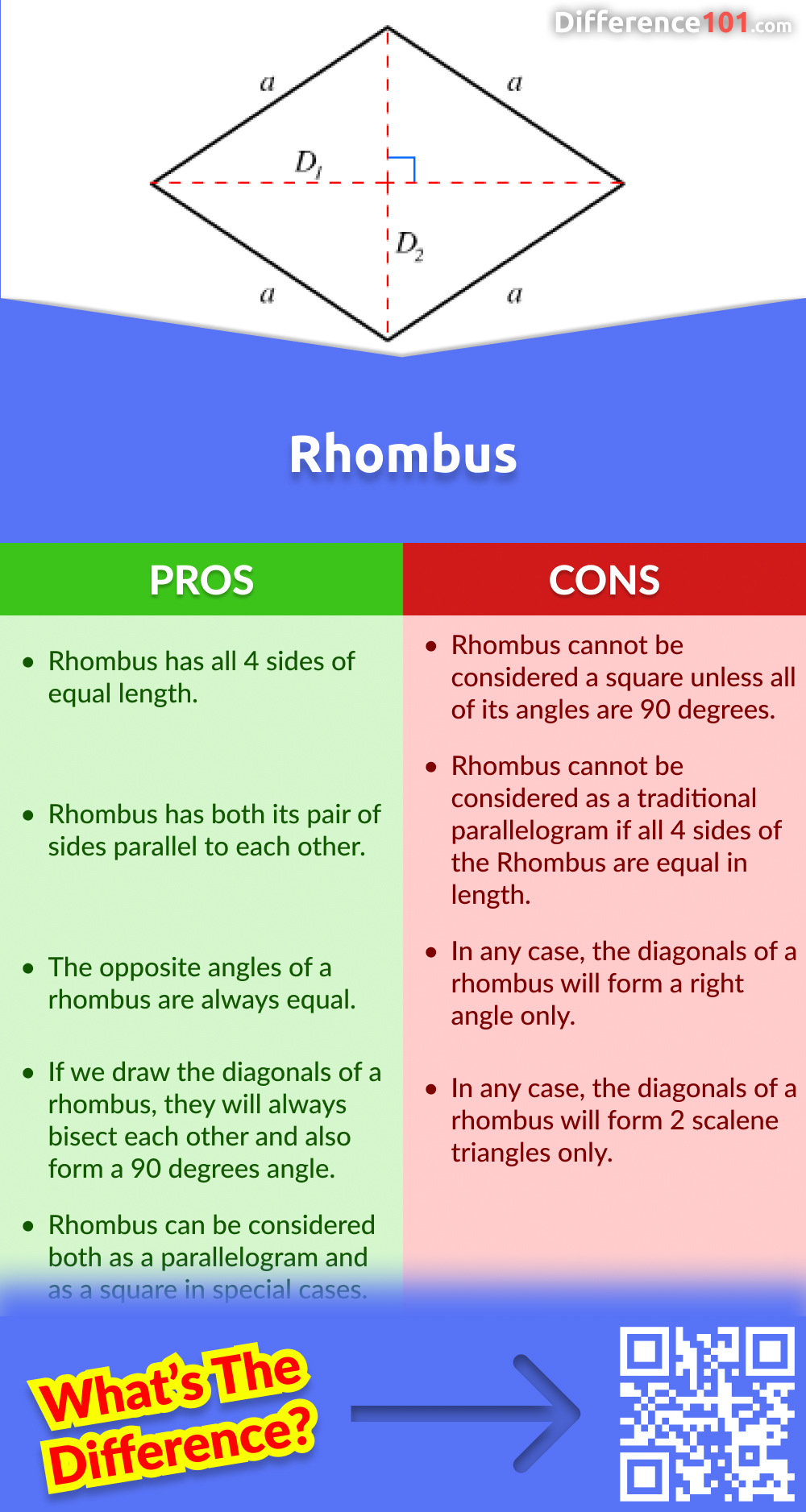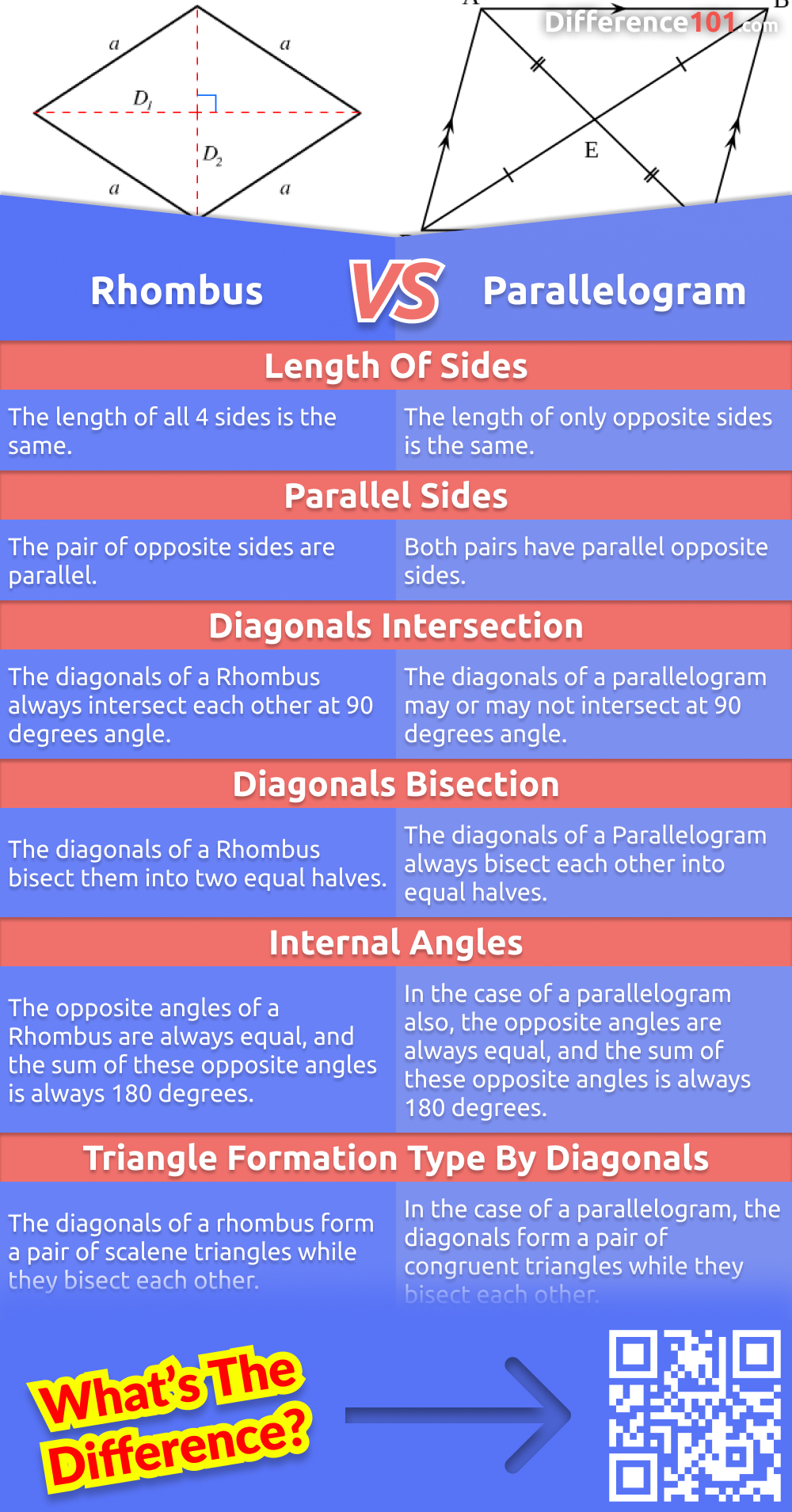Rhombus vs. Parallelogram: a rhombus is a quadrilateral with 4 sides and 4 corners where all these 4 sides have equal length and all their diagonals equally intersect each other at 90 degrees angle, whereas a parallelogram is again a quadrilateral with 4 edges and 4 sides where it may or may not have all these 4 sides equal, but their diagonals bisect each other in equal halves.
Let’s have a closer outlook towards Rhombus versus Parallelogram:
| Opposite Sides | Equal opposite sides |
| Diagonals Bisection | Parallelogram bisect each other equally |
| Diagonals Intersection | Rhombus intersect at 90 degrees |
| Parent Structure | Parallelogram is the parent structure |
Table of Contents
What is Rhombus?

A rhombus is a 2-dimensional geometrical structure. It is a quadrilateral with 4 sides where both pairs of opposite sides are equal in length and parallel in nature. Sometimes it is also denoted as a diamond or a rhombus diamond.
What is Parallelogram?

A parallelogram is a 2-dimensional geometrical quadrilateral with 4 sides where the pair of its opposite sides should be equal in length and parallel in nature. All 4 sides of a parallelogram may or may not be equal in length.
Rhombus vs. Parallelogram Comparison Table
| Structure | Rhombus | Parallelogram |
|---|---|---|
| Length of Sides | The length of all 4 sides is the same. | The length of only opposite sides is the same. |
| Parallel Sides | The pair of opposite sides are parallel. | Both pairs have parallel opposite sides. |
| Diagonals Intersection | The diagonals of a Rhombus always intersect each other at 90 degrees angle. | The diagonals of a parallelogram may or may not intersect at 90 degrees angle. |
| Diagonals Bisection | The diagonals of a Rhombus bisect them into two equal halves. | The diagonals of a Parallelogram always bisect each other into equal halves. |
| Internal Angles | The opposite angles of a Rhombus are always equal, and the sum of these opposite angles is always 180 degrees. | In the case of a parallelogram also, the opposite angles are always equal, and the sum of these opposite angles is always 180 degrees. |
| Triangle Formation Type by Diagonals | The diagonals of a rhombus form a pair of scalene triangles while they bisect each other. | In the case of a parallelogram, the diagonals form a pair of congruent triangles while they bisect each other. |
Rhombus vs. Parallelogram Pros and Cons
Rhombus Pros & Cons

Pros of a Rhombus Structure
- Rhombus has all 4 sides of equal length.
- Rhombus has both its pair of sides parallel to each other.
- The opposite angles of a rhombus are always equal.
- If we draw the diagonals of a rhombus, they will always bisect each other and also form a 90 degrees angle.
- Rhombus can be considered both as a parallelogram and as a square in special cases.
Cons of Rhombus Structure
- Rhombus cannot be considered a square unless all of its angles are 90 degrees.
- Rhombus cannot be considered as a traditional parallelogram if all 4 sides of the Rhombus are equal in length.
- In any case, the diagonals of a rhombus will form a right angle only.
- In any case, the diagonals of a rhombus will form 2 scalene triangles only.
Parallelogram Pros & Cons

Pros of Parallelogram Structure
- Parallelogram has its pair of opposite sides of equal length.
- Parallelogram has both its pair of sides parallel to each other.
- The opposite angles of a parallelogram are always equal.
- If we draw the diagonals of a rhombus, it will always bisect into equal halves.
- Parallelogram can be considered both as a rhombus and as a square in special cases.
Cons of a Parallelogram Structure
- Parallelogram cannot be considered a rhombus unless the length of all of its 4 sides is equal.
- Parallelogram cannot be considered a traditional square if all 4 sides of the parallelogram are equal in length and all of its angles are 90 degrees.
- In any case, the diagonals of a parallelogram will bisect into two equal halves only.
- In any case, the diagonals of a parallelogram will form 2 congruent triangles only.
Rhombus vs. Parallelogram Similarities Explained
- Both of these geometrical quadrilaterals have their pair of opposite sides equal.
- Both of these quadrilateral structures have their pair of opposite sides parallel.
- Both of these structures have their opposite angles equal and their sum equivalent to 180 degrees.
- Both Rhombus and Parallelogram can be considered as a square when all 4 of their sides are equal, and all the angles are equal to 90 degrees.
3 Key Differences Between a Rhombus and a Parallelogram You Should Know
There are some key differences when we compare a Rhombus with a Parallelogram.
| Basis | Rhombus | Parallelogram |
|---|---|---|
| All Sides | All sides of a rhombus are equal. | All sides of a parallelogram may or may not be equal. |
| Diagonals Bisection Angle | The diagonals of a rhombus bisect each other at 90 degrees angle. | The diagonals of a parallelogram bisect each other but may or may not form a 90 degrees angle during bisection. |
| Diagonal Triangle | For a rhombus, the triangle formed by the intersection of both diagonals is a scalene triangle. | For a parallelogram, the triangle formed by the intersection of both diagonals is a congruent triangle. |
Rhombus vs. Parallelogram vs. Square
If we compare these three quadrilaterals, then we will come to know that a square is a special case of both a rhombus and a parallelogram, and a rhombus is a special case of a parallelogram provided that the said rhombus or parallelogram should have all sides equal in length and all angles as 90 degrees.
Rhombus or Parallelogram for Usage
Rhombus for Usage
We should use a rhombus when there is a condition that all 4 sides of the quadrilateral should be equal, and we need a pair of scalene triangles with the diagonal intersection.
Parallelogram for Usage
We should use a parallelogram when there is a condition that only the pair of opposite sides of the quadrilateral should be equal and parallel, and we need a pair of congruent triangles with the diagonal intersection.
Comparison Chart

Comparison Video
The Final Words
Both rhombus and parallelogram are 2-dimensional geometric quadrilaterals with their opposite pair of sides equal and parallel in nature and also opposite pairs of equal angles. However, a parallelogram can be considered as a parent structure out of both rhombus and parallelogram. This is because a rhombus is a special case of a parallelogram where the parallelogram has all its 4 sides equal and parallel in nature. Hence, a rhombus can always be considered a parallelogram, but a parallelogram cannot always be considered a rhombus.
Rhombus & Parallelogram FAQs
Which is a parent quadrilateral Rhombus or Parallelogram?
Parallelogram.
Does a rhombus need to have all 4 sides equal and parallel always?
Yes, all 4 sides of a rhombus should be equal and parallel in nature.
Does a parallelogram need to have all 4 sides equal and parallel always?
It is not mandatory in the case of a parallelogram to always have all 4 sides equal and parallel in nature.
Does a rhombus always need to have its pair of opposite sides equal and parallel?
Yes, a rhombus should always have all its pair of opposite sides equal and parallel.
Does a parallelogram always need to have its pair of opposite sides equal and parallel?
Yes, a parallelogram should always have all its pair of opposite sides equal and parallel.
Do the diagonals of a rhombus always bisect each other at 90 degrees angle?
It is true that the diagonals of a rhombus bisect each other, but they may not bisect each other at 90 degrees angle always.
Do the diagonals of a parallelogram always bisect each other at 90 degrees angle?
Yes, the diagonals of a parallelogram always bisect each other forming a right angle. i.e., 90 degrees angle.
Which pair of triangles are formed by the diagonal intersection of a rhombus?
A pair of scalene triangles are formed by the diagonal intersection of a rhombus.
Which pair of triangles are formed by the diagonal intersection of a parallelogram?
A pair of congruent triangles are formed by the diagonal intersection of a parallelogram.
Can a Rhombus be considered a Parallelogram?
Yes, a rhombus can always be considered a parallelogram as it is a special case of a parallelogram.
Can a Parallelogram be considered a Rhombus?
No, a parallelogram can’t always be considered a rhombus as it may not always have all of its 4 sides of equal length.
Which is a parent structure, Rhombus or Parallelogram?
Out of Rhombus and Parallelogram, a parallelogram is the parent structure as a rhombus is a special case derived out of a parallelogram only.








